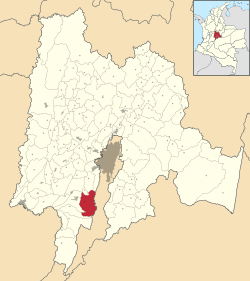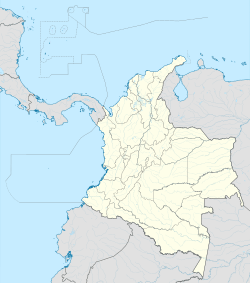Pasca facts for kids
Quick facts for kids
Pasca
|
|||
|---|---|---|---|
|
Town and municipality
|
|||

Pasca's church and museum façade
|
|||
|
|||

Location of the municipality and town of Pasca in the Department of Cundinamarca
|
|||
| Country | |||
| Department | |||
| Province | Sumapaz Province | ||
| Founded | 15 July 1537 | ||
| Founded by | Juan de Céspedes | ||
| Government | |||
| • Type | Municipality | ||
| Area | |||
| • Town and municipality | 264.24 km2 (102.02 sq mi) | ||
| • Urban | 0.27 km2 (0.10 sq mi) | ||
| Elevation | 2,180 m (7,150 ft) | ||
| Population
(2015)
|
|||
| • Town and municipality | 12,175 | ||
| • Density | 46.0755/km2 (119.335/sq mi) | ||
| • Urban | 2,841 | ||
| • Urban density | 10,520/km2 (27,300/sq mi) | ||
| Time zone | UTC-5 (Colombian Standard Time) | ||
| Website | Official website: http://www.pasca-cundinamarca.gov.co/ | ||
Pasca is a town and municipality in the Cundinamarca region of Colombia. It's located in the Andes mountains. Pasca is part of the Sumapaz Province. It's about 71 kilometres (44 mi) away from Bogotá, the capital city. Pasca is also known as the gateway to the Páramo del Sumapaz. This is the largest high-altitude wetland ecosystem in the world. The town sits at an elevation of 2,180 metres (7,150 ft). The area around Pasca ranges from 2,000 metres (6,600 ft) to 3,500 metres (11,500 ft) high.
Contents
What Does Pasca Mean?
The name Pasca comes from the Chibcha language. In this language, Pasca means "father's enclosure." This meaning was shared by Acosta Ortegón.
Pasca's History
Before the Spanish Arrived
Long ago, before the Spanish arrived, the area of Pasca was home to the Muisca. They were organized into a large group called the Muisca Confederation. The southern parts of the Muisca lands were ruled from a place called Muyquytá. Today, this place is known as Bogotá.
Spanish Conquest and Founding
On April 6, 1536, Spanish explorers began a difficult journey. Gonzalo Jiménez de Quesada and his brother Hernán Pérez de Quesada led 209 men. They arrived in Guachetá on March 12, 1537. From there, they set out to conquer the Muisca villages on the Bogotá savanna.
One of their captains was Juan de Céspedes. He reached Pasca in July 1537. Modern Pasca was officially founded on July 15, 1537. It was the last Muisca village to be conquered before the Spanish moved south. They then entered the lands of the Sutagao.
What Pasca Produces
Farming and Livestock
The main ways people make a living in Pasca are livestock farming and agriculture. Farmers grow many different crops. These include papa criolla (a type of potato) and other potatoes. They also grow peas, onions, and bunching onions.
Fruits and Vegetables
Other important crops are tree tomatoes, beans, and carrots. Farmers also grow cabbage, lettuce, tomatoes, and corn. You can find blackberries, coriander, and special Colombian fruits like gulupa and curuba here too.
Amazing Discoveries in Pasca
The Muisca Raft
In 1969, a very famous artifact was found in Pasca. It was the Muisca raft. This golden raft shows the ritual of El Dorado. This ritual involved a Muisca chief covered in gold. Today, the Muisca raft is a special part of the collection at the Gold Museum in Bogotá.
Local Museums
Pasca is also home to two interesting museums. One is an archaeological museum. Here, you can see ancient objects found in the area. The other is a natural history museum.
Famous People from Pasca
Pasca has been home to some notable people:
- Adolfo León Gómez: He was a Colombian poet and politician. He was born in Pasca. His grandmother, the poet Josefa Acevedo de Gomez, also lived and wrote her works here.
- Zoratama: This native leader lived in Pasca.
- Ivan Ramiro Sosa: A cyclist who has won many races.
Pasca's Climate
Pasca has a mild climate. The temperature stays fairly steady throughout the year. It gets a good amount of rain, especially from March to May and October to November.
| Climate data for Pasca, elevation 2,256 m (7,402 ft), (1981–2010) | |||||||||||||
|---|---|---|---|---|---|---|---|---|---|---|---|---|---|
| Month | Jan | Feb | Mar | Apr | May | Jun | Jul | Aug | Sep | Oct | Nov | Dec | Year |
| Mean daily maximum °C (°F) | 19.3 (66.7) |
19.4 (66.9) |
19.5 (67.1) |
19.3 (66.7) |
19.5 (67.1) |
19.4 (66.9) |
19.2 (66.6) |
19.5 (67.1) |
19.7 (67.5) |
19.4 (66.9) |
19.4 (66.9) |
19.4 (66.9) |
19.5 (67.1) |
| Daily mean °C (°F) | 15.7 (60.3) |
15.7 (60.3) |
15.9 (60.6) |
15.9 (60.6) |
15.9 (60.6) |
15.8 (60.4) |
15.6 (60.1) |
15.7 (60.3) |
15.9 (60.6) |
15.8 (60.4) |
15.7 (60.3) |
15.8 (60.4) |
15.8 (60.4) |
| Mean daily minimum °C (°F) | 10.3 (50.5) |
10.5 (50.9) |
11.2 (52.2) |
11.6 (52.9) |
11.6 (52.9) |
11.4 (52.5) |
11.1 (52.0) |
11.1 (52.0) |
10.9 (51.6) |
11.0 (51.8) |
11.1 (52.0) |
10.6 (51.1) |
11.0 (51.8) |
| Average precipitation mm (inches) | 53.3 (2.10) |
53.9 (2.12) |
92.0 (3.62) |
102.1 (4.02) |
84.0 (3.31) |
51.0 (2.01) |
45.4 (1.79) |
40.9 (1.61) |
57.0 (2.24) |
106.9 (4.21) |
113.3 (4.46) |
61.1 (2.41) |
860.7 (33.89) |
| Average precipitation days | 11 | 12 | 15 | 18 | 21 | 19 | 20 | 16 | 16 | 20 | 18 | 13 | 191 |
| Average relative humidity (%) | 84 | 85 | 86 | 87 | 87 | 87 | 86 | 85 | 85 | 86 | 87 | 85 | 86 |
| Mean monthly sunshine hours | 139.5 | 118.6 | 99.2 | 81.0 | 86.8 | 96.0 | 93.0 | 102.3 | 96.0 | 93.0 | 90.0 | 124.0 | 1,219.4 |
| Mean daily sunshine hours | 4.5 | 4.2 | 3.2 | 2.7 | 2.8 | 3.2 | 3.0 | 3.3 | 3.2 | 3.0 | 3.0 | 4.0 | 3.3 |
| Source: Instituto de Hidrologia Meteorologia y Estudios Ambientales | |||||||||||||
Images for kids
-
Muisca raft found in Pasca, showing the El Dorado ritual
See also
 In Spanish: Pasca para niños
In Spanish: Pasca para niños





